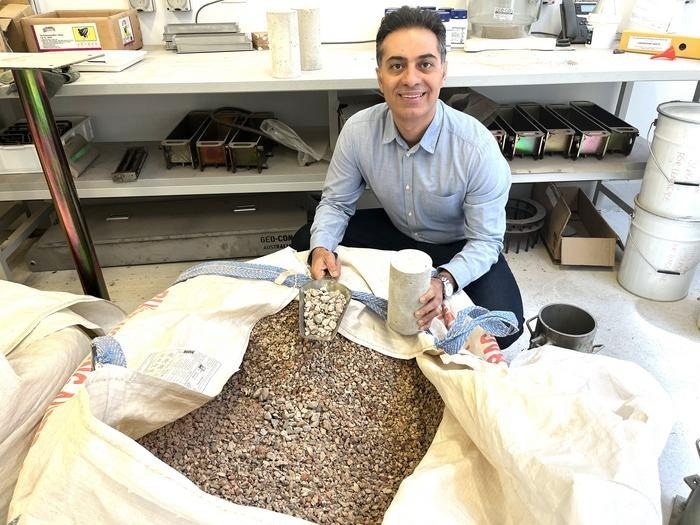In the aftermath of large-scale disasters like earthquakes or wars, and as aging buildings and infrastructure are replaced, vast amounts of concrete often end up in landfills or are crushed into rubble for use in road construction.
 Dr Aliakbar Gholampour, Senior Lecturer in Civil and Structural Engineering, College of Science and Engineering, Testing the Coarse Aggregates at Flinders University’s Tonsley Campus in Adelaide, South Australia. Image Credit: Flinders University
Dr Aliakbar Gholampour, Senior Lecturer in Civil and Structural Engineering, College of Science and Engineering, Testing the Coarse Aggregates at Flinders University’s Tonsley Campus in Adelaide, South Australia. Image Credit: Flinders University
Flinders University and The University of Melbourne specialists are evolving a “value add” for old broken concrete to “upcycling” coarse aggregate to produce a strong, durable, and workable concrete using a small amount of a secret ingredient, graphene, for a more sustainable approach.
The novel method is gaining traction with the discovery and extraction of new graphene deposits. This trend drives down the price of this raw material even as the costs of cement and aggregates continue to climb, according to researchers.
The results are tested by scientists using a weak graphene solution on recycled aggregates to manufacture concrete that is potentially superior to untreated recycled aggregates in cement-based mixtures.
There is an urgent demand for these methods in waste management, especially considering that demolition and construction waste products are projected to escalate to nearly 2.6 billion tons globally by 2030. Simultaneously, the concrete production process contributes to climate change through greenhouse gas emissions, while extraction methods exacerbate ecological impacts.
The quality of recycled concrete aggregates is refined to improve the quality, performance, and workability of recycled concrete aggregates and reduce the ecological footpaths.
This new form of treated recycled concrete aggregates may be more expensive to make right now, but when considering circularity and the life cycle of the materials, the costs are coming down rapidly.
Dr. Aliakbar Gholampour, Study First Author, Flinders University
The study was published in the journal Resources, Conservation and Recycling.
Dr. Gholampour is also a Senior Lecturer in Civil and Structural Engineering at Flinders University. He says the success of the novel method can help to meet the increasing demand for building materials around the world.
Dr. Gholampour, in partnership with University of Melbourne coauthor and Senior Researcher Dr. Massoud Sofi, Deputy Director (Research) at the Center for Recovered Resources (CoRR), has filed a patent for the research.
This research was funded by Flinders University and The University of Melbourne.
Journal Reference:
Gholampour, A., et al. (2023). Performance of concrete containing pristine graphene-treated recycled concrete aggregates. Science Direct. doi.org/10.1016/j.resconrec.2023.107266.